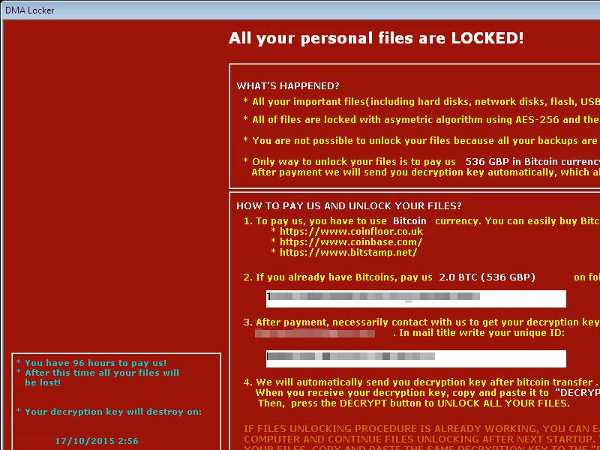RANSOM_MADLOCKER.B
a variant of Win32/Filecoder.DMALocker.A (ESET); Trojan-Ransom.Win32.Blocker.iadc (Kaspersky); Trojan.Ransomcrypt.AA (Symantec); Ransom.DMALocker (Malwarebytes); FileCryptor.GAV (AVG);
Windows


Threat Type: Trojan
Destructiveness: No
Encrypted: No
In the wild: Yes
OVERVIEW
Dropped by other malware, Downloaded from the Internet
This latest ransomware variant is dubbed as DMA Locker. It encrypts files on fixed, removable and network drives.
This Trojan arrives on a system as a file dropped by other malware or as a file downloaded unknowingly by users when visiting malicious sites.
It is capable of encrypting files in the affected system.
TECHNICAL DETAILS
97,824 bytes
EXE
Yes
16 Jan 2016
Encrypts files, Terminates processes
Arrival Details
This Trojan arrives on a system as a file dropped by other malware or as a file downloaded unknowingly by users when visiting malicious sites.
Installation
This Trojan drops the following copies of itself into the affected system and executes them:
- {variable path 1}\ntserver.exe
It drops the following file(s)/component(s):
- {variable path 1}\data_1.txt -> contains the date when ransomware was executed
- {variable path 1}\decrypting.txt
- {variable path 1}\start.txt
- {variable path 1}\cryptinfo.txt -> ransom note
It drops the following copies of itself into the affected system:
- {variable path 1}\fakturax.exe
Autostart Technique
This Trojan adds the following registry entries to enable its automatic execution at every system startup:
HKEY_LOCAL_MACHINE\Software\Microsoft\
Windows\CurrentVersion\Run
cssys = "{variable path 1}\ntserver.exe"
Other System Modifications
This Trojan adds the following registry entries:
HKEY_LOCAL_MACHINE\Software\Microsoft\
Windows\CurrentVersion\Run
cryptedinfo = "{variable path 1}\cryptinfo.txt"
Process Termination
This Trojan terminates the following processes if found running in the affected system's memory:
- rstrui.exe
- ShadowExplorer.exe
- sesvc.exe
- cbengine.exe
Other Details
This Trojan is capable of encrypting files in the affected system.
NOTES:
It avoids the following file paths:
- \Windows\
- \WINDOWS\
- \Program Files\
- \Program Files (x86)\
- Games
- \Temp
- \Sample Pictures
- \Sample Music
- \cache
- \Cache
It avoids the following file extensions:
- .exe
- .msi
- .dll
- .pif
- .scr
- .sys
- .msp
- .com
- .lnk
- .hta
- .cpl
- .msc
- C:\ProgramData
- %All Users Profile%\Dokumenty
- %All Users Profile%
Once the Trojan is executed, it displays the following window:

SOLUTION
9.800
12.318.08
05 Feb 2016
12.319.00
06 Feb 2016
Step 1
Before doing any scans, Windows XP, Windows Vista, and Windows 7 users must disable System Restore to allow full scanning of their computers.
Step 2
Note that not all files, folders, and registry keys and entries are installed on your computer during this malware's/spyware's/grayware's execution. This may be due to incomplete installation or other operating system conditions. If you do not find the same files/folders/registry information, please proceed to the next step.
Step 3
Restart in Safe Mode
Step 4
Search and delete this file
- {variable path 1}\data_1.txt
- {variable path 1}\decrypting.txt
- {variable path 1}\start.txt
- {variable path 1}\cryptinfo.txt
Step 5
Delete this registry value
Important: Editing the Windows Registry incorrectly can lead to irreversible system malfunction. Please do this step only if you know how or you can ask assistance from your system administrator. Else, check this Microsoft article first before modifying your computer's registry.
- In HKEY_LOCAL_MACHINE\Software\Microsoft\Windows\CurrentVersion\Run
- cssys = "{variable path 1}\ntserver.exe"
- cssys = "{variable path 1}\ntserver.exe"
- In HKEY_LOCAL_MACHINE\Software\Microsoft\Windows\CurrentVersion\Run
- cryptedinfo = "{variable path 1}\cryptinfo.txt"
- cryptedinfo = "{variable path 1}\cryptinfo.txt"
Step 6
Restart in normal mode and scan your computer with your Trend Micro product for files detected as RANSOM_MADLOCKER.B. If the detected files have already been cleaned, deleted, or quarantined by your Trend Micro product, no further step is required. You may opt to simply delete the quarantined files. Please check this Knowledge Base page for more information.
Did this description help? Tell us how we did.

